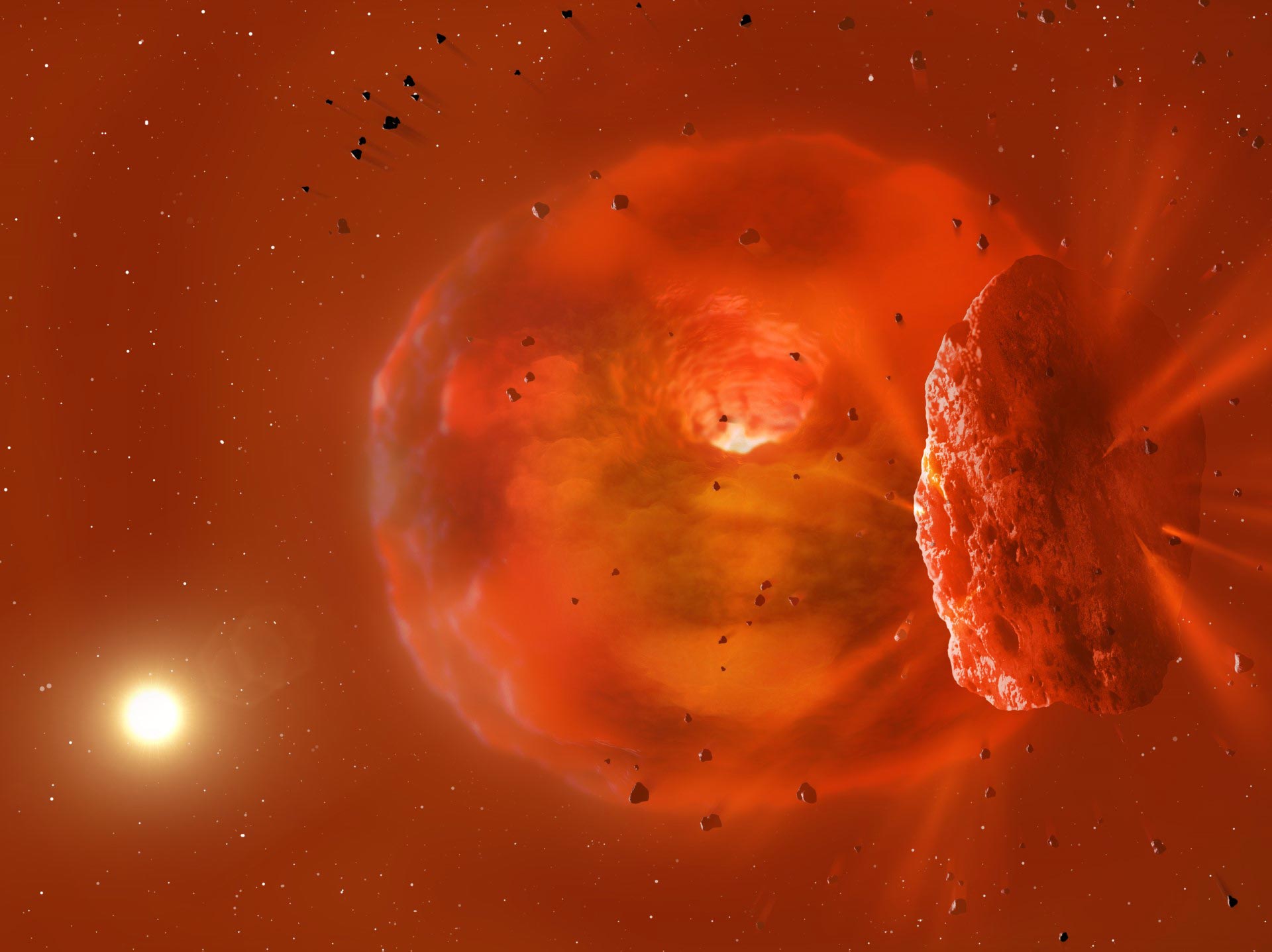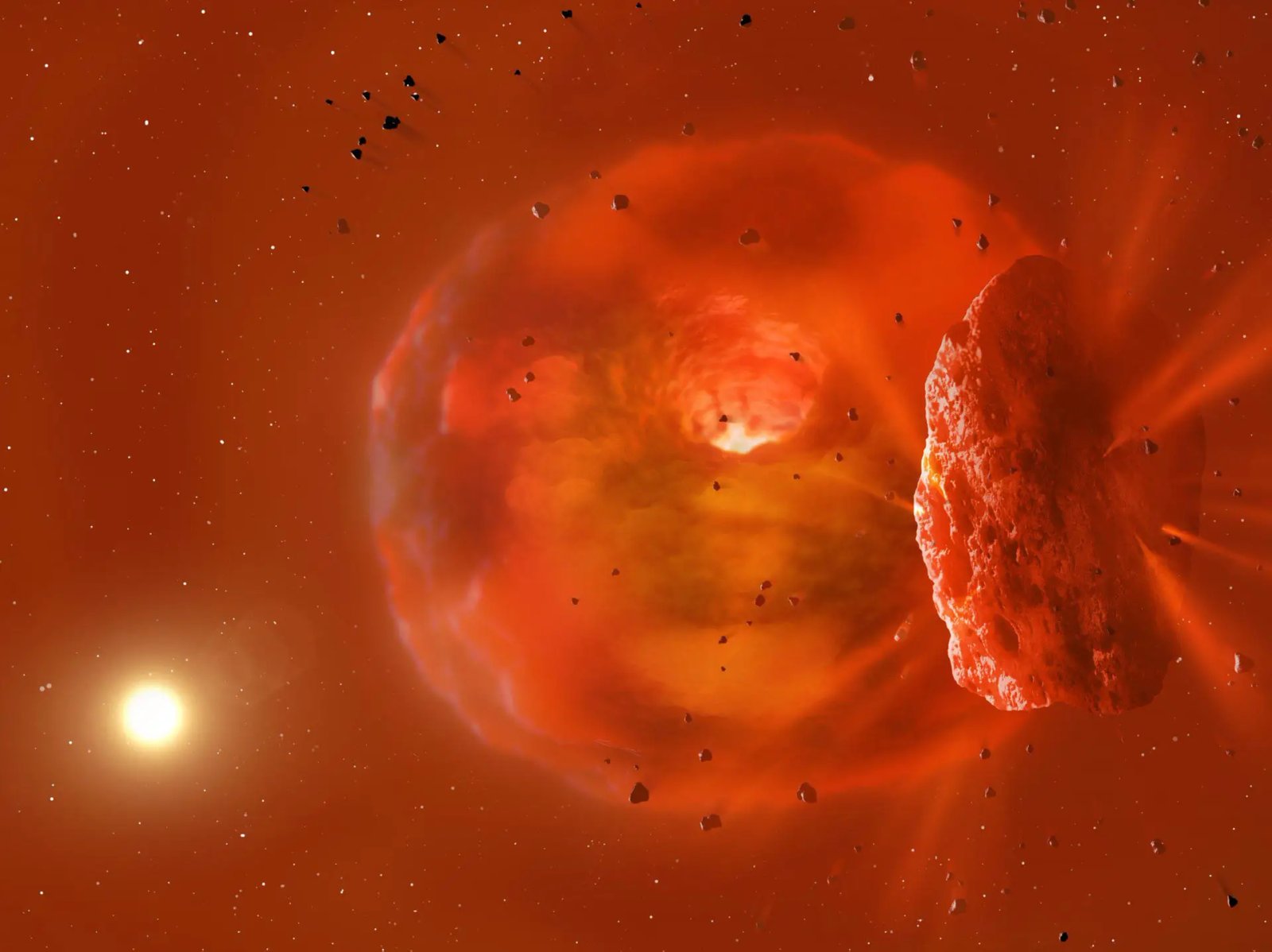
The image shows a visualization of a huge, glowing planetary body created by the collision of planets. In the foreground, fragments of ice and rock fly away from the impact and later cross between Earth and the host star, which can be seen in the background of the image. Credit: Mark Garlick
Scientists have observed two ice giant exoplanets collide around a Sun-like star, causing an intense flash of light and dust. This discovery, made by an international team of astronomers, could lead to the formation of new moons around the newly formed planet in the future.
A study published today (October 11) in Nature, reports the sighting of two ice giant exoplanets that collided around a Sun-like star, creating a flash of light and clouds of dust. Its findings show a bright thermal afterglow and the resulting cloud of dust that moved in front of the parent star, obscuring it over time.
Joint observation efforts
An international team of astronomers was formed after an enthusiast looked at a star’s light curve and noticed something strange. The system was shown to have doubled in brightness at infrared wavelengths about three years before the star began to fade in visible light.
Co-author Dr. Matthew Kenworthy of Leiden University said: “To be honest, this observation came as a complete surprise to me. When we initially shared the visible light curve of this star with other astronomers, we began to follow it with a network of other telescopes.
“An astronomer pointed out on social media that the star brightened in infrared light a thousand days before optical fading. That’s when I knew it was an unusual occurrence.”
Simulation of the collision of two ice giant bodies showing the simulated particles (top) and density (bottom) in a section through the midplane of impact. The scale expands during the simulation to track the expanding impact body and debris. Credit: University of Bristol
Star tracking and interpretation
A network of professional and amateur astronomers studied the star intensively, including tracking changes in the star’s brightness over the next two years. The star was named ASASSN-21qj after the network of telescopes that first detected the star’s fading at visible wavelengths.
The scientists concluded that the most likely explanation is that two ice giant exoplanets collided, producing the infrared glow detected NASAThe NEOWISE mission, which uses a space telescope to search for asteroids and comets.
Insights from co-lead researchers
Simon Lock, a research scientist in Earth Sciences at the University of Bristol, said: “Our calculations and computer models show the temperature and size of the glowing material, as well as how long the glow lasted. is consistent with the collision of two ice giant exoplanets.”
The resulting expanding cloud of debris from the impact then traveled in front of the star about three years later, causing the star’s brightness to dim at visible wavelengths.
Future observations and predictions
Over the next few years, the dust cloud is expected to begin to blur along the orbit of the collision remnant, and the bright scattering of light from this cloud could be detected by both ground-based telescopes and NASA’s largest telescope in space. , known as JWST.
Astronomers plan to keep a close eye on what happens next in this system.
Co-author Dr. Zoe Leinhardt, associate professor of astrophysics at the University of Bristol, added: “It will be fascinating to see what happens next. Eventually, the mass of material around the remnant may condense to form a family of moons that will orbit this new planet.
Reference: “The Aftermath of a Planetary Collision and the Transit of the Resulting Debris Cloud” by Matthew Kenworthy, Simon Lock, Grant Kennedy, Richelle van Capelleveen, Eric Mamajek, Ludmila Carone, Franz-Josef Hambsch, Joseph Masiero, Amy Mainzer, J. Davy Kirkpatrick, Edward Gomez , Zoë Leinhardt, Jingyao Dou, Pavan Tanna, Arttu Sainio, Hamish Barker, Stéphane Charbonnel, Olivier Garde, Pascal Le Dû, Lionel Mulato, Thomas Petit and Michael Rizzo Smith, 11 Oct 2023, Nature.
DOI: 10.1038/s41586-023-06573-9
